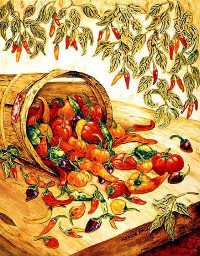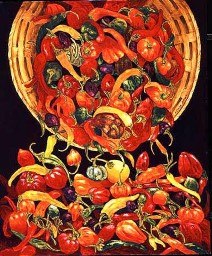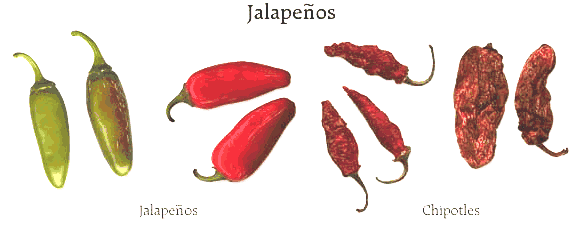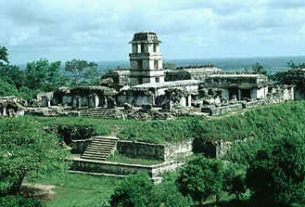Mexican Kitchen
Part 1 presented information on fresh chiles, capsicum anuum, New World natives that have become essential components in many of the world’s cuisines. One of their most intriguing aspects is the success with which they may be preserved by drying, nearly always changing the flavor of the original fresh chile.
This change in flavor can range from a subtle to a distinct difference, often depending upon the method by which they are dried. Mexican regional cooking reflects not only a variance in the types of chiles used, but also in local drying techniques.

Thus, a pasilla mexicana is a chilaca chile, grown in Central Mexico, which has usually been dried either in the sun or by a commercial dehydrating method, whereas a pasilla oaxaqueña has been smoked over open wood fires in the Sierra Mixe mountains. The latter is a small-scale, artisanal approach to drying chiles, the result of which is a unique flavor that cannot be duplicated outside the microclimate that produces both the chiles and the trees for firewood in that particular region.
Sun drying, oven drying and smoking are the most common small-scale methods of drying chiles. Commercially, the process of controlled artificial drying first dehydrates the chiles almost completely, then partially rehydrates them to optimum storage consistency. This method, however, does not work with thick-skinned varieties such as the jalapeño, which must be smoked in order to be preserved (at which point it is called a chipotle.)
Whichever drying method has been used, all dried chiles require some preparation before being used in a recipe, even if it is just washing, especially after having been dried outdoors. They should be wiped clean and dried well, in order to remove any dust that may have clung to the wrinkles in the skin.
Dried chiles are often dry-roasted on a comal or skillet to intensify their flavor. They should be turned once, just to the point of releasing their fragrance; if burned, they become bitter and should be discarded. Smooth-skinned varieties, such as cascabel and guajillo, tend to burn more easily than the thicker-skinned, wrinkled ones.

Softening dried chiles by soaking in hot water is another technique used in preparing them for recipes, especially sauces. Weighing them down with a plate will prevent them from floating to the surface of the water and thus speed up the soaking time.
In both the above instances, the chiles are usually seeded and deveined, although Mexican home cooks usually save the seeds, since they can be roasted and ground with the other ingredients if a sauce seems too bland. If the chiles are to be made into conserves, they are often used whole and not seeded and deveined. If being made into powder, they are dry ground.
Following is a list of Mexican dried chiles, and suggestions for their use in cooking. The combination of dried chiles with other ingredients provides a wonderful depth of flavor that is layered upon the taste imparted by curing or smoking. They lend themselves well to conserves and homemade chile powders, perfect kitchen projects for winter weekends.
Dried Chiles:
- Ancho:
- a mild, dried poblano chile, dark reddish-black, the backbone of many cooked sauces and stews, it is also soaked and used for making a version of chiles rellenos
- Cascabel:
- the dried form of fresh chile manzano, it has a deep reddish-brown color and nut-like flavor that makes it a good choice for Northern Mexican-style enchilada sauces
- Chilcostle :
- a small, hot, reddish-yellow chile, this is a common ingredient in the Oaxacan kitchen, used in its famous moles and manchamanteles
- Chile de arbol:
- a small, hot chile, used most frequently in table salsas and also crushed or ground and used as a spice, especially with fruit
- Chile onza amarillo:
- a small yellow chile from the southern Sierra de Juarez, it has a hot, musty flavor and is used to make mole amarillo- yellow mole
- Chilhuacle amarillo:
- another yellow mole ingredient, this small, tapered chile varies in color from yellow to orange-red and has a sharp, hot taste
- Chilhuacle negro:
- round and blue-black, from the La Cañada region of Oaxaca, this small, hot, thin-skinned chile is indispensable in making mole negro and chichilo, an unusual mole which uses the blackened seeds of the chile as one of its ingredients
- Chilhuacle rojo:
- small, dark red and tapering to a point, with a robust, fiery flavor, this chile is used to make mole colorado
- Chimayo:
- a mild, red chile, thinner but similar in taste to an ancho, this is frequently found in the cooking of Northern Mexico
- Chipotle:
- a mildly hot, smoke-dried jalapeño, it is a common ingredient in cooked salsas and often found in Central Mexico preserved in a brown sugar and vinegar marinade and called chipocludo; canned in seasoned sauce, it is chipotle adobado
- Chipotle meco: a dried, grayish-brown seedless jalapeño, this is sometimes called chile navideño because, reconstituted and stuffed, it is a traditional Christmas dish
- Chipotle tamarindo:
- the largest of the chipotles, it is named for its resemblance to a tamarind pod and, because of its size, it is among the dried chiles most prized for stuffing
- Costeño amarillo:
- as its name implies, it is from the coast – in this case the southern Oaxacan coast; small, hot and yellow, it is a classic mole amarillo ingredient
- Costeño rojo:
- hot, reddish colored and thin-skinned, this chile comes from the Jimaltepec area and flavors the fiery southern coastal dishes Guajillo: one of the most commonly used throughout the country, this long, slim, dark reddish-brown chile has a mild, rich flavor and is often used with some of its seeds to add a piquant “boost” to cooked sauces and stews
- Morita:
- a small, hot, smoky chile used in table sauces, it is usually toasted and ground with other toasted ingredients to produce a flavorful salsa
- Mulatto:
- a nearly black variety of ancho, and often used interchangeably with it, this is one of the requisites for a classic mole poblano
- Pasilla:
- a hot, dried chilaca, this chile is most often used in meat stews and is also required for mole poblano
- Piquín:
- very small and very hot, this is a fiery addition to table salsas throughout the country.
- Serrano seco:
- the serrano is dried at its reddest and ripest and its heat becomes more concentrated, making it a suitable substitute for either chile de arbol or piquín
Some Culinary Uses of Dried Chiles
- Table Salsas:
- Dried chiles are used in roasted table salsas, which require each ingredient to be roasted/toasted on the comal and then coarsely ground in the molcajete or by briefly pulsing in a blender or food processor. Using the seeds from the chiles will intensify the “heat” of the sauce. Fragrant, deep red roasted salsas compliment grilled and roasted meat; adding a spoonful does wonders for a bowl of chicken, beef or vegetable soup
- Cooked Sauces:
- Many guisados-stews- as well as moles and several enchilada sauces use dried chiles. In these dishes, the chiles are usually first toasted just to the point of fragrance, then soaked to soften before being combined with other sauce ingredients
- Chiles en Conserva:
- The “smoky” flavored dried chiles, such as chipotles and moritas, lend themselves to sweet-and-hot chile conserves. Fruit vinegar, such as pineapple or apple cider vinegar, and piloncillo, the very dark brown Mexican sugar, form the base to which herbs, spices and the chiles are added.
- Chiles Rellenos:
- Yes, dried chiles can be stuffed, too. They need to be soaked first to soften them, but then can be handled as any other chiles rellenos, and are especially good baked in sauces. Ancho, chipotle meco and tamarindo are all excellent for preparing this way.
Some Recipes . . .
- Chipocludos: Smoked Chile Conserves
- Anchos Con Salsa de Cilantro y Crema: Stuffed Anchos in Cilantro Cream Sauce
(From Part I)
- Rajas con Crema: Fresh Chile Strips in Cream Sauce
- Chiles en Escabeche: Pickled Fresh Chiles with Vegetables


